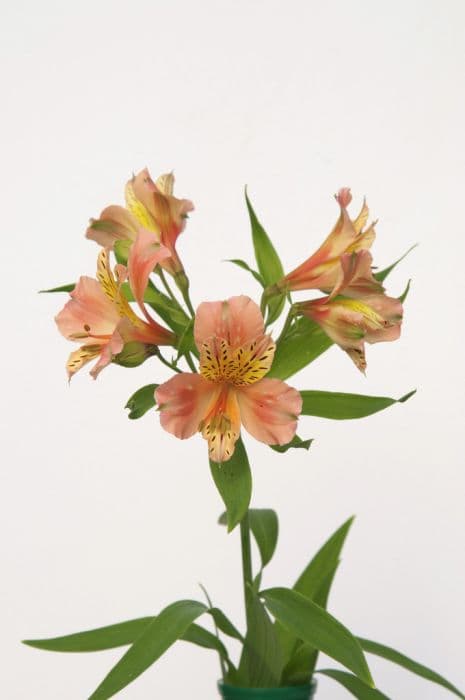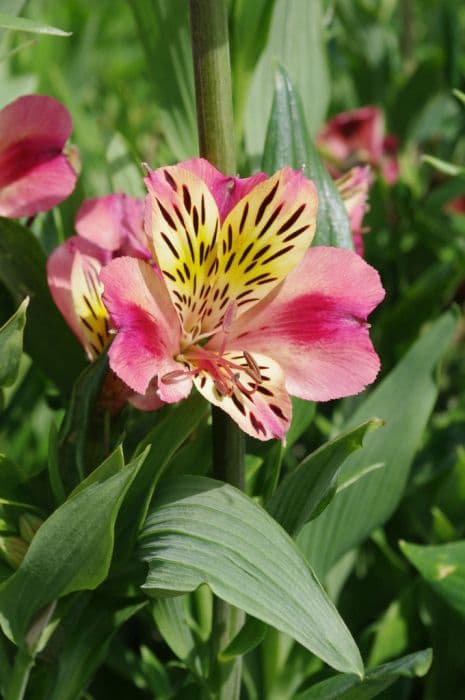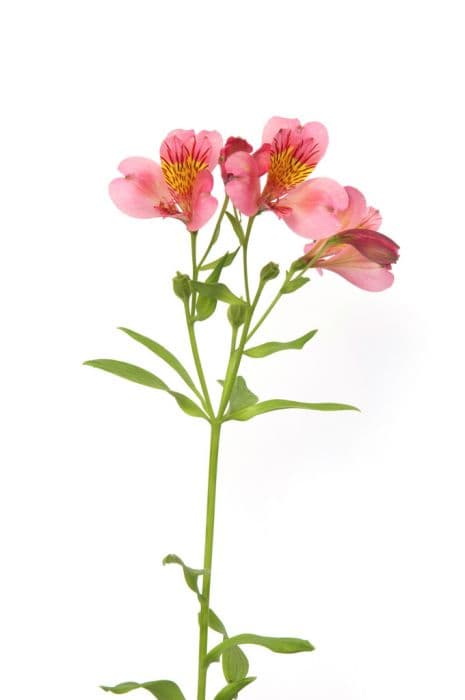Peruvian Lily Alstroemeria 'Selina'

ABOUT
Alstroemeria 'Selina' is a stunning flowering plant renowned for its vibrant and eye-catching blooms. The flowers are characterized by their striking colors, usually a harmonious blend of pink and orange hues, which create a tropical feel in any garden. Each blossom has three petals and three sepals that closely resemble the petals, and these are often adorned with dark streaks or spots, which add to their exotic appeal. The petals may display a gradient of color, transitioning from a deeper hue at the edges to a softer tone near the center. The foliage of Alstroemeria 'Selina' is equally appealing, with lance-shaped leaves that exhibit a glossy green appearance. The leaves often grow in a dense, bushy manner which provides a lush backdrop for the showy flowers. This dense foliage gives the plant a full and vibrant look even when it's not in bloom. The plant bears these beautiful flowers on sturdy, upright stems that emerge from a clump of the green foliage at the base. The stems themselves are smooth, and they hold the flowers aloft, making them excellent for cutting and adding to bouquets. Alstroemeria 'Selina' has a clumping habit, with new shoots sprouting from underground rhizomes, forming an attractive, verdant mass in the garden. Overall, its appearance is one that is cherished by gardeners and floral enthusiasts for the lively splash of color and beauty it adds to any setting.
About this plant
 Names
NamesFamily
Alstroemeriaceae
Synonyms
Peruvian Lily, Lily of the Incas, Parrot Lily
Common names
Alstroemeria 'Selina'.
 Toxicity
ToxicityTo humans
The Alstroemeria, commonly known as Peruvian Lily, generally has a low level of toxicity to humans. While it's not typically considered dangerous, ingestion of parts of the plant can potentially cause mild gastrointestinal discomfort, nausea, vomiting, or diarrhea. It is always advisable to handle Peruvian Lily with care as some individuals may be sensitive to the plant and can develop dermatitis upon contact with its sap. Consumption, particularly in large amounts, should be avoided. If symptoms of poisoning occur after ingestion, it is important to seek medical advice.
To pets
The Peruvian Lily is considered to be mildly toxic to pets, such as cats and dogs. If a pet ingests parts of the plant, it may experience gastrointestinal upset, including symptoms like vomiting and diarrhea. Generally, the plant is not life-threatening, but if a pet consumes a large quantity of the Peruvian Lily and shows signs of distress, it is important to contact a veterinarian. Preventing access to these plants can ensure that pets remain safe from potential toxic effects.
 Characteristics
CharacteristicsLife cycle
Perennials
Foliage type
Deciduous
Color of leaves
Green
Flower color
Mixed
Height
2-3 feet (60-90 cm)
Spread
1-2 feet (30-60 cm)
Plant type
Bulb
Hardiness zones
7
Native area
South America
Benefits
 General Benefits
General Benefits- Long-lasting blooms: Alstroemeria 'Selina', also known as Peruvian Lily, produces flowers that can last for several weeks both in the garden and as cut flowers in a vase, providing lasting beauty and color.
- Vibrant colors: The Peruvian Lily offers a range of vibrant colors, which can brighten up any garden or bouquet with its striking hues.
- Attracts pollinators: These flowers are known for attracting bees, butterflies, and hummingbirds to the garden, helping to pollinate other plants.
- Low maintenance: Once established, Alstroemeria 'Selina' is relatively low maintenance, requiring minimal care beyond occasional watering and fertilizing.
- Drought tolerance: Alstroemeria 'Selina' has good drought tolerance, making it suitable for gardens in drier climates or for gardeners who prefer plants that don't require frequent watering.
- Versatile planting: It can be planted in beds, borders, and containers, giving gardeners flexibility in how they incorporate it into their garden design.
- Rapid growth: Peruvian Lilies tend to grow quickly and can fill in spaces in the garden, providing a lush look in a relatively short amount of time.
- Easy propagation: They can be easily propagated through division, allowing gardeners to increase their stock and share with others.
 Medical Properties
Medical PropertiesThis plant is not used for medical purposes.
 Air-purifying Qualities
Air-purifying QualitiesThis plant is not specifically known for air purifying qualities.
 Other Uses
Other Uses- Flower Photography: Alstroemeria, with their vivid colors and intricate patterns, are often used as subjects for macro photography, attracting both amateur and professional photographers.
- Eco-friendly Confetti: Dried petals from the Alstroemeria can be used as a natural and biodegradable alternative to traditional paper confetti at events.
- Art Inspiration: The unique color combinations and patterns on Alstroemeria petals can serve as creative inspiration for artists in painting or textile design.
- Edible Arrangements: Although not commonly consumed, Alstroemeria petals are non-toxic and can be used as decorative elements in culinary presentations.
- Dye Source: The colorful Alstroemeria petals can be boiled to extract natural dyes for fabrics or crafting projects.
- Greeting Cards: Pressed Alstroemeria flowers are often used in handmade paper or greeting cards for a touch of elegance and texture.
- Bookmark Crafting: Using pressed and dried Alstroemeria flowers, one can create personalized bookmarks, perfect for gifts or to accompany a book release.
- Floral Scented Sachets: Dried Alstroemeria petals can be added to sachets to give a subtle floral fragrance to drawers and wardrobes.
- Wedding Decor: These flowers can be woven into hair wreaths or garlands for a rustic and colorful touch in wedding ceremonies.
- Plant Companionship: Alstroemeria can be planted alongside vegetables to attract pollinators and enhance the biodiversity of a home garden.
Interesting Facts
 Feng Shui
Feng ShuiThe Peruvian Lily is not used in Feng Shui practice.
 Zodiac Sign Compitability
Zodiac Sign CompitabilityThe Peruvian Lily is not used in astrology practice.
 Plant Symbolism
Plant Symbolism- Friendship - Alstroemeria, also known as Peruvian Lily, is often symbolic of lasting friendship, reflecting the twisted nature of its leaves which represent the ups and downs of relationships.
- Devotion - The Peruvian Lily represents a strong bond between two people, often used to indicate a deep commitment and mutual support.
- Wealth and Prosperity - With its multiple blooms per stem, the Peruvian Lily can symbolize abundance and wealth, making it a good gift for wishing someone financial success.
- Achievement - The vibrant blooms and resilience of the Peruvian Lily are seen as a representation of reaching one's goals and persevering through difficult challenges.
- Good Luck - Given as a gift, the Peruvian Lily is said to bring good luck to the recipient, due to its lush and attractive flowers that suggest a positive future.
 Water
WaterThe Peruvian Lily, commonly known as Alstroemeria 'Selina', prefers consistently moist soil, so water when the top inch of soil starts to dry out. Typically, this would mean watering once or twice a week, but this can change based on temperature and humidity levels. During the growing season, you might need to water the plant with about 1 gallon per week, adjusting for rainfall and weather conditions. Ensure that the plant is watered deeply so the moisture reaches the roots rather than just wetting the surface. Overwintering plants require less water, scaling back to keep the soil slightly moist but not soggy.
 Light
LightPeruvian Lily thrives in bright, indirect sunlight. It's best placed in a spot where it can receive full sun in the morning with some afternoon shade to protect it from intense, direct light. Ensuring your Alstroemeria 'Selina' gets at least 6 hours of sunlight each day will promote vigorous growth and abundant flowering.
 Temperature
TemperatureThe Peruvian Lily prefers temperature ranges between 65 and 80 degrees Fahrenheit for optimal growth. It can survive temperatures as low as 23 degrees Fahrenheit for short periods but is not frost-tolerant. Avoid exposing Alstroemeria 'Selina' to temperatures above 90 degrees Fahrenheit for prolonged periods to prevent heat stress.
 Pruning
PruningRegularly deadhead spent flowers on the Peruvian Lily to encourage further blooming and maintain a tidy appearance. After the blooming season, cut back the stems by about one-third to rejuvenate the plant and promote growth for the next season. Pruning is typically done at the end of the summer or in early fall before the plant goes dormant.
 Cleaning
CleaningAs needed
 Soil
SoilFor the Peruvian Lily, a well-draining soil is essential, consisting of a mix of loam, sand, and peat with a pH between 6.5 and 7.0, ensuring fertile conditions for optimum growth.
 Repotting
RepottingPeruvian Lilies should be repotted every two to three years or when the pot becomes crowded to maintain their vigor and promote healthy blooming.
 Humidity & Misting
Humidity & MistingPeruvian Lilies thrive best in moderate humidity levels, preferably around 50%, avoiding excessively dry or damp conditions to promote healthy growth.
 Suitable locations
Suitable locationsIndoor
Provide bright, indirect light and protect from direct sun.
Outdoor
Plant in a sheltered spot with partial shade and well-draining soil.
Hardiness zone
7-10 USDA
 Life cycle
Life cycleAlstroemeria 'Selina', also known as Peruvian Lily 'Selina', begins its growth from tuberous rhizomes which sprout stems and foliage in early spring. The plant then enters a vegetative stage where leaves expand, and it develops a strong root system. Following this, in late spring to early summer, it transitions to the flowering stage, producing vibrant blooms that are often used in cut flower arrangements. After flowering, the plant sets seed, though many cultivars, including 'Selina', are often propagated vegetatively rather than from seed. Once the flowering and seed-setting stages are complete, the plant begins to die back in late summer or early fall, entering a period of dormancy during the cooler months. Throughout its life cycle, Alstroemeria 'Selina' can also spread by its rhizomes, forming larger clumps year after year if conditions are favorable.
 Propogation
PropogationPropogation time
Spring-Early Summer
The Alstroemeria 'Selina', commonly known as the Peruvian Lily 'Selina', is typically propagated through division, which is the most popular method for this plant. This process is ideally carried out in the late winter or early spring, just before the new growing season begins. To propagate by division, carefully dig up the plant and gently separate the rhizomes, ensuring that each division has at least one or two shoots or growth points. Replant these divisions at the same depth they were originally growing, spacing them about 12 to 24 inches (30 to 60 cm) apart to allow room for growth. The divided plants should be watered thoroughly after planting to help establish them in their new locations. This straightforward method helps to rejuvenate overcrowded clumps and provides a way to increase your stock of Peruvian Lilies efficiently.




![Peruvian lily [H.R.H. Princess Alice]](/_next/image?url=https%3A%2F%2Fplants-admin.emdemapps.com%2Fimages%2Fplants%2F%2Fimages%2F604b55e81c8b0.png&w=640&q=75)
![Peruvian lily [Indian summer]](/_next/image?url=https%3A%2F%2Fplants-admin.emdemapps.com%2Fimages%2Fplants%2F%2Fimages%2F604b616bc746b.png&w=640&q=75)
![Peruvian lily [Inticancha Creamy Dark Pink]](/_next/image?url=https%3A%2F%2Fplants-admin.emdemapps.com%2Fimages%2Fplants%2F%2Fimages%2F604b5e98bea7c.png&w=640&q=75)
![Peruvian lily [Inticancha Dark Purple]](/_next/image?url=https%3A%2F%2Fplants-admin.emdemapps.com%2Fimages%2Fplants%2F%2Fimages%2F604b5381bb78f.png&w=640&q=75)
![Peruvian lily [Inticancha Imala]](/_next/image?url=https%3A%2F%2Fplants-admin.emdemapps.com%2Fimages%2Fplants%2F%2Fimages%2F604b619b522ba.png&w=640&q=75)
![Peruvian lily [Inticancha Red]](/_next/image?url=https%3A%2F%2Fplants-admin.emdemapps.com%2Fimages%2Fplants%2F%2Fimages%2F604b5aebac273.png&w=640&q=75)